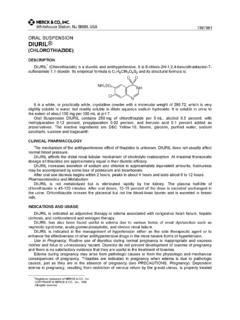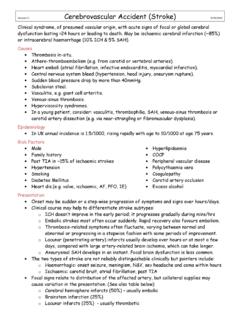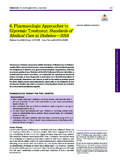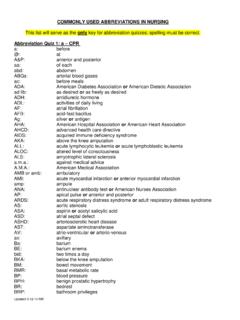Transcription of Norvasc® - HYPERTENSION MEDICATIONS …
1 1 Norvasc (amlodipine besylate) Tablets DESCRIPTION NORVASC is the besylate salt of amlodipine, a long-acting calcium channel blocker. Amlodipine besylate is chemically described as 3-Ethyl-5-methyl ( )-2-[(2-aminoethoxy)methyl]-4-(2-chlorop henyl)-1,4-dihydro-6-methyl-3,5-pyridine dicarboxylate, monobenzenesulphonate. Its empirical formula is C20H25 CIN2O5 C6H6O3S, and its structural formula is: NHClOH3 COOCH3OH3 CONH2C6H6O3S Amlodipine besylate is a white crystalline powder with a molecular weight of It is slightly soluble in water and sparingly soluble in ethanol.
2 NORVASC (amlodipine besylate) tablets are formulated as white tablets equivalent to , 5 and 10 mg of amlodipine for oral administration. In addition to the active ingredient, amlodipine besylate, each tablet contains the following inactive ingredients: microcrystalline cellulose, dibasic calcium phosphate anhydrous, sodium starch glycolate, and magnesium stearate. CLINICAL PHARMACOLOGY Mechanism of Action Amlodipine is a dihydropyridine calcium antagonist (calcium ion antagonist or slow-channel blocker) that inhibits the transmembrane influx of calcium ions into vascular smooth muscle and cardiac muscle.
3 2 Experimental data suggest that amlodipine binds to both dihydropyridine and nondihydropyridine binding sites. The contractile processes of cardiac muscle and vascular smooth muscle are dependent upon the movement of extracellular calcium ions into these cells through specific ion channels. Amlodipine inhibits calcium ion influx across cell membranes selectively, with a greater effect on vascular smooth muscle cells than on cardiac muscle cells. Negative inotropic effects can be detected in vitro but such effects have not been seen in intact animals at therapeutic doses.
4 Serum calcium concentration is not affected by amlodipine. Within the physiologic pH range, amlodipine is an ionized compound (pKa= ), and its kinetic interaction with the calcium channel receptor is characterized by a gradual rate of association and dissociation with the receptor binding site, resulting in a gradual onset of effect. Amlodipine is a peripheral arterial vasodilator that acts directly on vascular smooth muscle to cause a reduction in peripheral vascular resistance and reduction in blood pressure. The precise mechanisms by which amlodipine relieves angina have not been fully delineated, but are thought to include the following: Exertional Angina: In patients with exertional angina, NORVASC reduces the total peripheral resistance (afterload) against which the heart works and reduces the rate pressure product, and thus myocardial oxygen demand, at any given level of exercise.
5 Vasospastic Angina: NORVASC has been demonstrated to block constriction and restore blood flow in coronary arteries and arterioles in response to calcium, potassium epinephrine, serotonin, and thromboxane A2 analog in experimental animal models and in human coronary vessels in vitro. This inhibition of coronary spasm is responsible for the effectiveness of NORVASC in vasospastic (Prinzmetal s or variant) angina. Pharmacokinetics and Metabolism: After oral administration of therapeutic doses of NORVASC, absorption produces peak plasma concentrations between 6 and 12 hours.
6 Absolute bioavailability has been estimated to be between 64 and 90%. The bioavailability of NORVASC is not altered by the presence of food. Amlodipine is extensively (about 90%) converted to inactive metabolites via hepatic metabolism with 10% of the parent compound and 60% of the metabolites excreted in the urine. Ex vivo studies have shown that approximately 93% of the circulating drug is bound to plasma proteins in hypertensive patients. Elimination from the plasma is biphasic with a terminal elimination half-life of about 30-50 hours.
7 Steady-state plasma levels of amlodipine are reached after 7 to 8 days of consecutive daily dosing. The pharmacokinetics of amlodipine are not significantly influenced by renal impairment. Patients with renal failure may therefore receive the usual initial dose. 3 Elderly patients and patients with hepatic insufficiency have decreased clearance of amlodipine with a resulting increase in AUC of approximately 40-60%, and a lower initial dose may be required. A similar increase in AUC was observed in patients with moderate to severe heart failure.
8 Pediatric Patients: Sixty-two hypertensive patients aged 6 to 17 years received doses of NORVASC between mg and 20 mg. Weight-adjusted clearance and volume of distribution were similar to values in adults. Pharmacodynamics Hemodynamics Following administration of therapeutic doses to patients with HYPERTENSION , NORVASC produces vasodilation resulting in a reduction of supine and standing blood pressures. These decreases in blood pressure are not accompanied by a significant change in heart rate or plasma catecholamine levels with chronic dosing.
9 Although the acute intravenous administration of amlodipine decreases arterial blood pressure and increases heart rate in hemodynamic studies of patients with chronic stable angina, chronic oral administration of amlodipine in clinical trials did not lead to clinically significant changes in heart rate or blood pressures in normotensive patients with angina. With chronic once daily oral administration, antihypertensive effectiveness is maintained for at least 24 hours. Plasma concentrations correlate with effect in both young and elderly patients.
10 The magnitude of reduction in blood pressure with NORVASC is also correlated with the height of pretreatment elevation; thus, individuals with moderate HYPERTENSION (diastolic pressure 105-114 mmHg) had about a 50% greater response than patients with mild HYPERTENSION (diastolic pressure 90-104 mmHg). Normotensive subjects experienced no clinically significant change in blood pressures (+1/ 2 mmHg). In hypertensive patients with normal renal function, therapeutic doses of NORVASC resulted in a decrease in renal vascular resistance and an increase in glomerular filtration rate and effective renal plasma flow without change in filtration fraction or proteinuria.



![Heart Failure Pathophysiology.ppt [Read-Only]](/cache/preview/5/6/a/8/a/5/4/1/thumb-56a8a5411198557184679ccfbe445eec.jpg)





